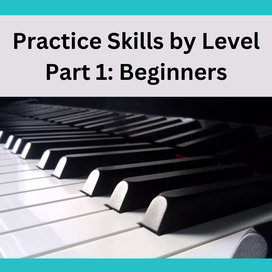
This spring on my blog, I will be sharing a four-part series on teaching practice skills to students at each level of development. These articles will feature my best tips and tricks for how to help students learn to practice efficiently and in an age-appropriate and level-appropriate way.
Today's article is all about practice skills for beginners! Keep reading to see more...
At the elementary level, students should be learning that practice is something that needs to be done consistently, and "practicing" a piece is very different from simply "playing" a piece one time through.
However, we also want to look for ways to make practicing enjoyable, so that it becomes a special part of each day that students look forward to--not just another chore to check off their list.
Here are my best practice tips for beginners:
1. Help students and parents establish a practice routine.
Work with parents to find a time when students can practice free from interruptions or distractions. Before school, after school, after dinner…choose a time that students can set aside for piano practice on a daily basis so that practice becomes an expected part of their routine.
2. Focus on task-based practice, instead of time-based practice.
Parents often ask how many minutes each day students should be practicing. However, quantity does not necessarily equal quality when it comes to practicing!
I find it much more helpful to give beginners a list of 3 to 4 short activities they can do each day as part of their practice routine. These activities can include, for example: doing a warm-up exercise, practicing a new piece (more on that below), reviewing a repertoire piece, listening to a piece of music, playing a theory game or app, etc.
Keep the tasks short and clearly worded in your student's assignment book. And don't forget to make sure that parents are aware of what tasks your student should be doing each day so they can provide help and support as needed.
3. Model good practice habits as part of every lesson.
This is a good idea for students at every level, but especially for beginners who are still learning what “practice” entails.
During the lesson, take students through a sample “practice session” so they know exactly what they should be doing at home. Go through each task on their assignment sheet together and have students check it off the list as you complete it.
I also find it helpful to mark each assigned piece in a book with a sticky note so that students (and parents) can find the correct page in their books quickly and easily.
4. Work on “thoughtful repetition.”
Practice does involve playing pieces multiple times. However, mindless repetition doesn’t benefit anyone!
I like to show students how fun it can be to play a piece many different ways. Here is just a sampling of some of the ways you can ask students to practice a piece:
- Clap and count the rhythm.
- Play and name each note.
- Play and count out loud.
- Play and sing the words.
- Play and say each finger number.
- Play the piece up high on the piano, then down low on the piano.
- Play the piece loud, then soft.
- "Play" the piece silently, on the closed piano lid, and imagine the sound of the notes.
- Play along with a backing track or duet part.
As you can see, there is no shortage of creative practice tasks you can give your students. Variety is the spice of life, and this is especially true when practicing!
And speaking of practice tasks....
5. Practice through play.
Did you know that play-based learning has been shown to boost not only enjoyment when learning, but to increase brain development and skill acquisition as well?
Finding ways to "gamify" practice tasks is a great way to turn beginning students into enthusiastic practicers. A few ideas you might try:
- Ask students to roll dice and play a measure or line of music that number of times.
- Small toys, like legos or action figures, make great practice counters to encourage students to practice a piece more than one time.
- Stuffed toys make great “practice buddies” for young students. Students might enjoy playing a piece for their favorite toy, or even taking suggestions and directions from their toy as well (instead of from a teacher or parent!).
- And, of course, there are a variety of music apps and games designed to help students with concepts like rhythm, note names, keyboard geography, and more.
6. Encourage the support and involvement of family and friends on a regular basis.
- Ask students to teach a piece to a parent or older sibling. This is a great way to build confidence and help students review what they have learned.
- Put a "tip jar" on the piano at home where parents can put in a dollar or a treat and request a piece from a student’s repertoire list that they would like to hear.
- Do regular Zoom performances for grandparents and extended family who live far away.
- Plan a special "bring a friend" day, where students can bring a friend to lessons and show off what they have learned.
What do you think? What tips and tricks have you found helpful for teaching your beginners how to practice? I would love to hear from you in the comments!

 RSS Feed
RSS Feed